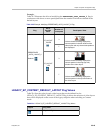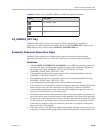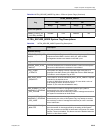
Polycom RealPresence Collaboration Server (RMX) 1500/2000/4000
22-48 Polycom, Inc.
Flags Specific to Maximum Security Environments - Ultra Secure Mode
The RMX can operate in one of two modes: Standard Security Mode or Ultra Secure Mode.
In Ultra Secure Mode the enhanced security features of the version are rigorously enforced.
The Ultra Secure Mode is enabled or disabled depending on the value of the
ULTRA_SECURE_MODE System Flag.
Ultra Secure Mode, is enabled by manually adding the ULTRA_SECURE_MODE flag to the
System Configuration and setting its value to YES.
Ultra Secure Mode Flag
Guidelines
• Ultra Secure Mode is disabled by default and can be enabled by changing the value of the
ULTRA_SECURE_MODE System Flag to YES during First Entry Configuration or at any
time using the Setup > System Configuration menu.
• After modifying the value of the ULTRA_SECURE_MODE System Flag to YES, all
RMX users are forced to change their Login passwords.
• When upgrading from a version containing a JITC_MODE System Flag, the system will
automatically create an ULTRA_SECURE_MODE System Flag and set it to the value of
the JITC_MODE flag before the upgrade.
The system will then delete the JITC_MODE System Flag.
• When downgrading to a version that utilizes the JITC_MODE System Flag, the
administrator will need to set the JITC_MODE flag to the value of the
ULTRA_SECURE_MODE flag’s value before the upgrade.
WARNING: Once Ultra Secure Mode is enabled it can only be undone by performing a Restore to
Factory Defaults. Also, to implement a Maximum Security environment, other Polycom products on
the network must be similarly configured.
For more information see "Restoring Defaults” on page J-1.
When the ULTRA_SECURE_MODE flag is set to YES, Version 7.8 does not include support for:
• Connection to Alternate Management
Network via LAN3 port
• SUPPORT user
• Auditor user
• Chairperson user
• Connections to External Databases
• IP Sec security protocols
• ISDN Cascade
• Serial connection
• Modem connection
• MPM cards
• SIP
• SIP security (Digest)
• SIP TLS
• SNMP
• SSH server.
• USB key configuration
• Web link (Hyperlink in Participant Properties
dialog box)
• QoS with IPv6
• Recording link


















